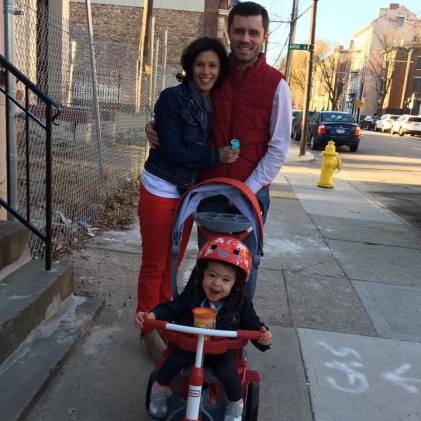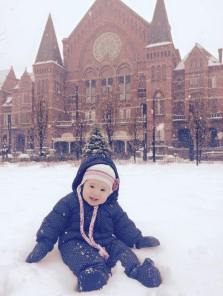
“We finally did it,” says Janice Liebenberg of completely rehabbing a building in OTR with her husband and daughter. She is quick to add, “And we will NEVER do it again!”
Janice trod a long road to arrive at her urban dream home. She started down the path about sixteen years ago. The new millennium found Janice, originally from South Africa, living in Cincinnati. She came; she liked what she saw. “There was already a real energy about the place, and I wanted to be a part of it.” She met Andy Holzhauser, the man who would become her husband, at a special event at the Contemporary Arts Center. She finished school and got a job working for Scripps. With plenty of incentive to stick around the Queen City, Janice decided to stay.
In the early part of their relationship, OTR was just becoming a date-night destination. Washington Park was still a gravel pit. Nonetheless, Janice and Andy came to be a part of the neighborhood. They moved into the Hale-Justis building on East Central Parkway. They welcomed the opening of the first restaurants on Vine Street. Janice became more and more involved in the Cincinnati arts community, serving on the board of the Cincinnati Opera and then switching careers to join the development team at ArtsWave. She and Andy, founder the Greater Cincinnati Energy Alliance, took to walking to work and ditching the car during the week. Life was now in OTR, and the two, now married, decided to make it their permanent home.
 At the time of their search, the building they fell in love with was part of 3CDC’s ‘Park Haus‘ project. “Building ‘green’ was our biggest priority,” she says. “We wanted to buy the shell of a building, choose our own architects and be involved in every detail of our house” Not all of their plans, however, were available through ‘Park Haus.’ After long negotiations with 3CDC the couple entered into purchasing contract as long as they could line up the financing to complete the project.
At the time of their search, the building they fell in love with was part of 3CDC’s ‘Park Haus‘ project. “Building ‘green’ was our biggest priority,” she says. “We wanted to buy the shell of a building, choose our own architects and be involved in every detail of our house” Not all of their plans, however, were available through ‘Park Haus.’ After long negotiations with 3CDC the couple entered into purchasing contract as long as they could line up the financing to complete the project.
At this point of the story, however, the home-buying process started to slow down. Although the couple had chosen a property and wanted to move ahead with the development of the property, they were unable to find a bank willing to take the risk of financing an independent project. They schlepped around town to all of the big names, but none of these major players found the idea of financing a small project in an as-yet undeveloped neighborhood particularly attractive.
 An accurate appraisal of the project proved to be the greatest obstacle on the course. At the time, single-family homes were an anomaly in the neighborhood, so there were no comparable standards of measure for their project. Appraisers neglected the couple’s development plans and kept producing estimates that reflected the property’s foreclosure cost from years ago.
An accurate appraisal of the project proved to be the greatest obstacle on the course. At the time, single-family homes were an anomaly in the neighborhood, so there were no comparable standards of measure for their project. Appraisers neglected the couple’s development plans and kept producing estimates that reflected the property’s foreclosure cost from years ago.
Janice and Andy finally found a way forward working with Central Bank from Kentucky. A small bank that maintains mortgages in house, the institution was willing to work with the couple, understand their vision, and become a part of it. With the bank, Janice and Andy found an appraiser who helped them think of the property in a new way, not just as a single-family home, but as an apartment building in which their residence occupies the majority of space.
The result of the project, a collaboration with Daniels Homes, is a four-unit building that is LEED Platinum certified. The group earned the certification by making environmental choices from top to bottom – quite literally, since they installed solar panels on the roof. Environmentally responsible choices continue throughout the home. Working together with Greener Stock, they found the greenest materials available, including Marmoleum floors in the bedrooms. “They are made out of flax seed,” notes Janice. “You could probably eat them.” The walnut floors throughout the home come from within five-hundred miles of Cincinnati. Maintaining respect for the past while incorporating the latest environmentally friendly technologies, the complex also boasts competitive state and federal historic tax credits.
Janice and Andy, sitting together with their daughter Olivia, look around their home and sigh with relief. “We’re here, though it was a long time coming.” But they are encouraged by their ordeal and know they can help others endure it. “The point now is for us to share our experience with other people. They should know that it’s possible – that everything is possible: restoring historic property, building green, family life, community engagement. It’s all happening here.”

We need to be sure that the old rates of property taxes are maintained for long time residents of Over the Rhine. This bit of thoughtful management has worked very well in other major urban centers where “pioneers” do not wish to displace poorer older residents. It doesn’t really cost the city much but it keeps the character of the neighborhoods what everyone wants–and that’s irreplaceable. Previous transient residents who were not long-time residents do not benefit from the lower property tax rates, just the ones who have made the neighborhood their home for many years.
Mary Anne Curtis, M.D.